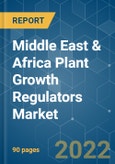The Middle East & Africa Plant Growth Regulators Market is projected to grow at a CAGR of 6.6% during the forecast period (2020-2025).
Key Highlights
- There has been an increasing demand for fruits in Egypt and South Africa, and the application of plant growth regulators (PGRs) on fruit crops is continuously increasing. Similarly, in Africa, plant growth regulators are highly used for vegetables, such as potatoes, tomatoes, and onions. Fruits are enhanced by the application of PGR, in the case of apples, pears, and peaches, in Turkey.
- South Africa is expected to be the fastest-growing PGR market in Africa during the forecast period. The major factors driving the growth of the South African market are the increase in the consumption of fruits, such as grapes and bananas, and the increasing income of farmers. Furthermore, increasing fruit cultivation in the country is also driving the market, and the same trend is expected to follow during the forecast period.
Key Market Trends
Increasing in Demand For Sustainable Agricultural Practises
Agriculture plays a crucial role in the economic development of Africa. However, the sector is performing below its potential. Currently, around 60% of Africa’s population depends on agriculture for livelihood, yet the sectorial contribution to the GDP was only 21% in 2017. While Africa has the highest area of uncultivated arable land in the world, amounting to nearly 202 million hectares in 2016, its productivity is far behind the other developing regions. Moreover, crop yields are only reaching 56% of the international average. The application of plant growth regulators may help in increasing the blossom rate, stimulating plant growth, and delaying the onset sprouting of root crops, among others. Thus, the rising demand for field crops in the region, coupled with increasing innovation in the Plant growth regulators portfolio pertaining to cotton crops, is providing opportunities for further penetration in field crops.
Crop-Based Plant Growth Regulators Holds a Prominent Share
Plant growth regulators are used in specific crops, such as fruits and cereals. In South Africa, major fruit production are citrus, Banana, mangoes, litchi, and grapes. More than 40% of agricultural exports include fruits, which is a major contributor to South Africa’s Growth Domestic Profit (GDP) that account for 2.5%. The African plant growth regulator market demand is led by agricultural countries, like South Africa and Egypt. Cereals and oilseeds are the major consumers of plant growth regulators followed by fruits and vegetables. The demand for plant growth hormone is high in South Africa, as they are extensively used for banana crops. The three main reasons for using PGRs on bananas is to improve the post-harvest increase yields, green life, and to alleviate plant stress. The companies are targeting the African region for the future growth of the industry. Investments in R&D for capping down the prices of plant growth regulator products to increase the yield for major crops is the major driver, which, in turn, is expected to boost the plant growth regulators market, during the forecast period.
Competitive Landscape
Nufarm Ltd, Zagro, ADAMA, UPL, and Syngenta are some of the prominent players operating in the market studied. These companies are strengthening their positions by expanding their presence in the region. Additionally, these players are partnering with local distribution retailers to sell their PGR products in the region. For instance, Zagro partnered with local retailers to increase its market share.
Additional Benefits:
- The market estimate (ME) sheet in Excel format
- 3 months of analyst support
This product will be delivered within 2 business days.
Table of Contents
Companies Mentioned (Partial List)
A selection of companies mentioned in this report includes, but is not limited to:
- BASF SE
- Bayer Crop Science
- Corteva Agriscience
- Crystal Crop Protection Pvt. Limited
- Sumitomo Chemicals Co. Ltd
- NuFarm Ltd
- Zagro
- UPL Limited
- ADAMA Ltd
- Syngenta AG
Methodology

LOADING...








